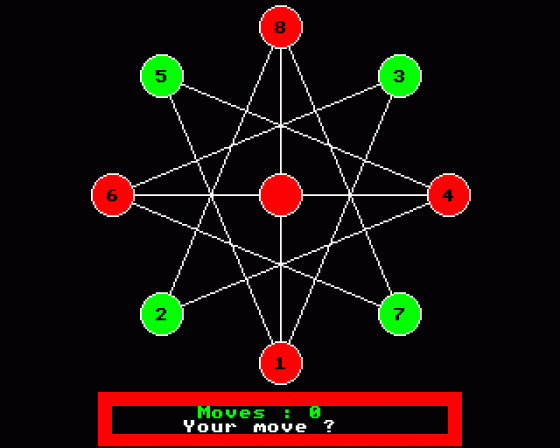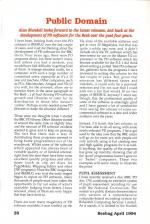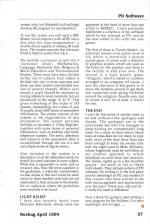
Beebug
 1st April 1994
1st April 1994
Categories: Review: Software
Author: Alan Blundell
Published in Beebug Volume 12 Number 10
Alan Blundell looks forward to the latest releases, and back at the development of PD software for the Beeb over the past four years.
Public Domain
I have been looking back over the PD columns in Beebug over the last couple of years, and it set me thinking about the development of PD software for the BBC micro. Four years ago, there were PD programs about, but there weren't many, and unless you had a modem, you would have had difficulty in getting hold of them. A strange situation really, for a computer with such a large number of committed users, especially as it's a 10 year old machine. Other computers, such as PCs, Macintoshes, Amigas and STs (if you will, for the moment, allow me to mention them in the same paragraph as the Beeb ...) all had thriving PD software growth and libraries to cater for its distribution to those who weren't 'online'. Perhaps it only needed some PD libraries to make the situation different.
Those were my thoughts when I started the BBC PD library. Other libraries started at around the same time or slightly later, and the amount of PD software available seemed to grow and to keep on growing. The fact that there was a way of distributing their programs seemed to bring home programmers out of the woodwork. Whilst some of the software which appeared has always been of variable quality or of limited interest, right from the start there have been some excellent quality programs and other items (such as clip art discs for PageMaker, Wapping Editor and other DTP programs). Since the BBC magazines (and Beebug was in at the early stages) began to report on PD software, many thousands of people must have taken the opportunity to try out some of what's available. Judging from letters I have received, many of them are very happy that they have done so.
There are now many megabytes of PD software available; I once totalled up the file sizes of the available software and got to over 30 Megabytes, but that was quite a while ago now, and it didn't include all of the PC software which has been tested for use on the Master 512 co-processor or the PD software which has become available for the 512. I did think about writing a potted 'best PD software' list, gathered from the programs I have reviewed in writing this column for the last couple of years. But, given that everyone has different tastes and interests, it could only be a personal selection and I'm not sure that I could pick out a list that would fit on two pages of Beebug anyway! I must say, though, that the professional quality of some of the software is amazingly good and I have gained a lot of satisfaction from seeing the release of some ex-commercial software to a new and wider audience over the years.
Instead, I'll finish this last column, as I've been able to do all along, with some newly-released PD programs. I have got used to the idea now that the BBC micro will go on for years yet, with people not only actively using it but creating new and high quality programs for it as well. If anything, the quality of the programs has gone up recently, showing that all the 'good' programmers haven't gone on to 'better' computers. These two examples will serve nicely to illustrate the point.
Pupil Assessment
I have recently received a disc (BBC PD disc 174) containing an extensive system of pupil assessment recording for use with the National Curriculum. The system is a public domain demonstration only version of a comprehensive computer-based recording system by Birkenhill Computing Services Limited. As it stands, it is limited to the Scottish system only, but Birkenhill will willingly develop the program for use elsewhere.
To run the system you will need a BBC Master microcomputer with ADFS and a disc drive (for class reorganisation - a double drive) capable of reading 80 track discs. The system assumes that sideways RAM is fitted in socket Nos 4 & 6.
The Scottish curriculum is split into 5 'curricular areas'; Mathematics, Language, Expressive Arts, Religious & Moral Education and Environmental Studies. These areas have been divided further into fifteen subjects. Each subject is divided into one or more outcomes and these are then further sub-divided into one of several strands. Within each strand a pupil should be assessed as having attained a level, normally, but not exclusively in the range 'A' to 'E'. This gives something of the order of 183 strands, representing, for a class of, say, 30 pupils, some 5,500 items of assessment information. The prime concern of the system is the organisation of this information. The system provides facilities to maintain a 'Class Register' together with some items of personal information, such as address and home telephone number. The entry, alteration and retrieval of the assessment data is accomplished through the use of a fast and simple series of logical menus.
Also included in the system is a description of all the attainment levels, by strand, for every outcome in every subject. While this is apparently no more, and on occasion less, than the texts supplied in the guidelines, a relatively convenient, on-line access to this text could be more useful to those teachers who had not yet memorised it, than recourse to the drawer, file or cupboard, where the guidelines were normally to be found.
Light Relief
I have also recently heard from Miroslaw Bobrowski, whose name has appeared at the head of more than one article in Beebug. I have previously mentioned a collection of his software which he has released as PD, and he has now added to this with two new games.
The first of these is Puzzle Master, an enhanced version of an earlier work of his, which is essentially a picture puzzle game. It comes with a selection of graphics screens which are used as the basis for the puzzles, and there is the facility to add your own. The second is a logic puzzle game, Octagram, which is based on numbers arranged in an octagram (of course...) and the objective of the game is to move the numbers around to get them into numerical order going clockwise around the octagram. Sounds easy, but of course it isn't (or at least, it wasn't for me).
The End
I can't let this series of articles come to an end without a few apologies and thanks. The apologies are to the unfortunate few who I've managed to keep waiting for unreasonably long times for a reply to their letters (there have at times been far too many to cope with, most of the time there have just been enough to keep me awake only half the night) and to Mike Williams, whose fingernails must be well bitten at my creative approach to article deadlines on more than one occasion. The thanks rightly go to a few hundred people - too many to list or thank individually. They include writers of PD software, for writing it in the first place and for releasing it as PD, and readers of this column who have written to me with encouragement and appreciation over the years. Thank you, one and all - it really has made a difference!
Now, I think I'm going to start writing a new program for the children. I've been meaning to do it for ages...
This article was converted to a web page from the following pages of Beebug Volume 12 Number 10.






